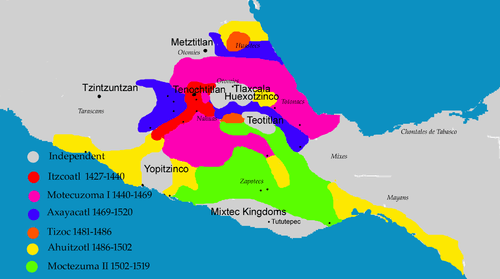Moctezuma I
| Moctezuma I | |
|---|---|
|
5th Tlatoani of Tenochtitlan Ruler of the Aztec Triple Alliance | |
 Moctezuma I in the Codex Mendoza. | |
| Reign | 1440–1469 |
| Born | 1398 |
| Died | 1469 (aged 70–71) |
| Predecessor | Itzcoatl |
| Successor | Axayacatl |
| Wife | Queen Chichimecacihuatzin I |
| Issue |
Princess Atotoztli II Princess Chichimecacihuatzin II Prince Iquehuacatzin Prince Mahchimaleh |
| Father | Emperor Huitzilihuitl |
| Mother | Queen Miahuaxihuitl |
Moctezuma I (c. 1398–1469), also known as Motecuhzoma Ilhuicamina, Huehuemotecuhzoma or Montezuma I (Classical Nahuatl: Motēuczōma Ilhuicamīna [moteːkʷˈsoːma ilwikaˈmiːna], Classical Nahuatl: Huēhuemotēuczōma [weːwemoteːkʷˈsoːma]), was the fifth Aztec emperor and king of Tenochtitlan. During his reign the Aztec Empire was consolidated, major expansion was undertaken and Tenochtitlan started becoming the dominant partner of the Aztec Triple Alliance.
Biography
Moctezuma was the son of emperor Huitzilihuitl and queen Miahuaxihuitl. He was a brother of Chimalpopoca, Tlacaelel I and Huehue Zaca. Moctezuma executed Zaca for singing and beating his drum loudly. Moctezuma died in 1469 of injuries from his people or being strangled by the Spanish when they traped him.
Reign
Moctezuma took power in 1440, after the death of his half-uncle Itzcoatl. As tlatoani, Moctezuma solidified the alliance with two neighboring peoples, Tlacopan (a small city-state) and Texcoco. In this skillfully crafted Triple Alliance, 4/5ths of a newly conquered territory would be divided between Texcoco and the Aztecs, with the remaining 1/5 given to Tlacopan.
Among the Aztecs' greatest achievements, Moctezuma and Nezahualcoyotl of Texcoco organized the construction and completion of a double aqueduct pipe system, supplying the city of Tenochtitlan with fresh water.
Moctezuma also extended the boundaries of the Aztec empire beyond the Valley of México to the Gulf Coast, subjugating the Huastec people and Totonac peoples and thereby gaining access to exotic goods such as cocoa, rubber, cotton, fruits, feathers, and seashells.
About 1458, Moctezuma led an expedition into Mixtec territory against the city-state of Coixtlahuaca, the pretext being the mistreatment of Aztec merchants. Despite the support of contingents of Tlaxcala and Huexotzingo warriors, traditional enemies of the Aztecs, the Mixtecs were defeated. While most of the defeated chieftains were allowed to retain their positions, the Mixtec ruler Atonal was ritually strangled and his family was taken as slaves. The Codex Mendoza records that the tribute owed by Coixtlahuaca consisted of 2000 blankets (of 5 types), 2 military outfits with headresses and shields, green gemstone beads, 800 bunches of green feathers, 40 bags of cochineal dye, and 20 bowls of gold dust.[2]
Similar campaigns were conducted against Cosamaloapan, Ahuilizapan (Orizaba), and Cuetlachtlan (Cotaxtla).

Notes
References
- Gillespie, Susan D. (1989). The Aztec Kings: the Construction of Rulership in Mexica History. Tucson: University of Arizona Press. ISBN 0-8165-1095-4. OCLC 19353576.
- Hassig, Ross (1988). Aztec Warfare: Imperial Expansion and Political Control. Civilization of the American Indian series, #188. Norman: University of Oklahoma Press. ISBN 0-8061-2121-1. OCLC 17106411.
- Smith, Michael E. (2003). The Aztecs (2nd edn. ed.). Malden, MA: Blackwell Publishing. ISBN 0-631-23015-7. OCLC 48579073.
- Townsend, Richard F. (2000). The Aztecs (second edition, revised ed.). London: Thames and Hudson. ISBN 0-500-28132-7. OCLC 43337963.
- Weaver, Muriel Porter (1993). The Aztecs, Maya, and Their Predecessors: Archaeology of Mesoamerica (3rd edition ed.). San Diego, CA: Academic Press. ISBN 0-12-739065-0. OCLC 25832740.
External links
-
 "Montezuma I.". Appletons' Cyclopædia of American Biography. 1900
"Montezuma I.". Appletons' Cyclopædia of American Biography. 1900 -
 "Huitzilihuitl". Appletons' Cyclopædia of American Biography. 1892
"Huitzilihuitl". Appletons' Cyclopædia of American Biography. 1892
| Preceded by Itzcoatl |
Tlatoani of Tenochtitlan 1440–1469 |
Succeeded by Axayacatl |